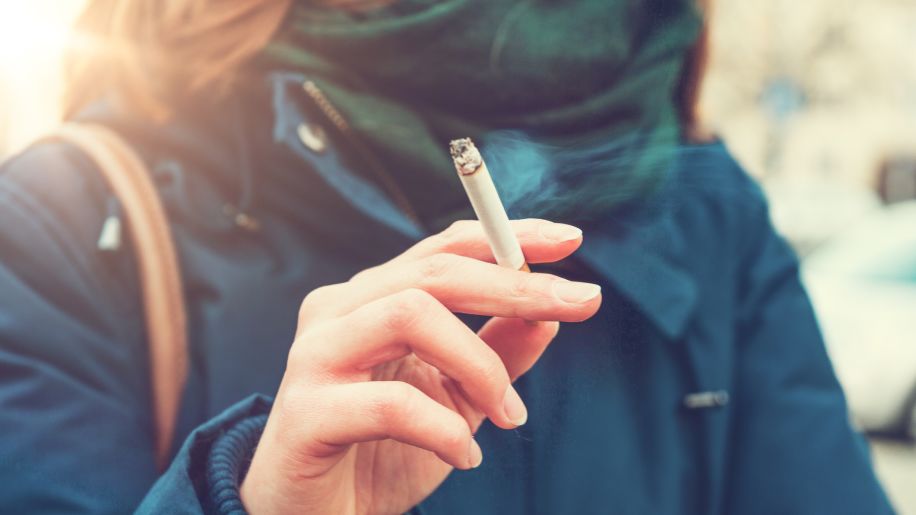5 ways to overcome cigarette cravings
Quitting is hard, but not impossible. Try these approaches to help reduce your cravings for a smoke.
Updated on October 16, 2024

You know how bad smoking is for you. It’s the leading cause of preventable death in the United States, responsible for more than 480,000 deaths every year. And that’s probably why you decided to quit.
But quitting isn’t as easy as just putting down your pack. A 2016 study published in BMJ Open suggests it may take 30 or more times trying to quit smoking to be successful.&… Show More
You know how bad smoking is for you. It’s the leading cause of preventable death in the United States, responsible for more than 480,000 deaths every year. And that’s probably why you decided to quit.
But quitting isn’t as easy as just putting down your pack. A 2016 study published in BMJ Open suggests it may take 30 or more times trying to quit smoking to be successful.
Here's what you need to know about cravings—and how to reduce cravings to make the process of quitting easier to handle.
Show Less
Nicotine and your brain
There are more than 7,000 chemicals in tobacco smoke, but the nicotine in cigarettes is what’s habit-forming. When you light up, molecules of nicotine travel to your brain, where they attach to parts of brain cells called acetylcholine receptors. These receptors play a part in body functions like… Show More
There are more than 7,000 chemicals in tobacco smoke, but the nicotine in cigarettes is what’s habit-forming. When you light up, molecules of nicotine travel to your brain, where they attach to parts of brain cells called acetylcholine receptors. These receptors play a part in body functions like muscle movement, breathing, heart rate, learning, and memory. They also trigger the release of other chemicals that affect mood, appetite, and other functions.
Nicotine also triggers the release of dopamine in the brain’s reward system, which is a key component in addiction. (The reward system is the part of the brain that generates feelings of satisfaction or pleasure in response to certain experiences or forms of stimulus.)
Show Less
Why it’s so hard to quit
As your body gets addicted to nicotine, it gets to the point where not having it makes you feel sick. This is called withdrawal. Common withdrawal symptoms include anxiety, depression, trouble sleeping, headaches, increased appetite, and trouble concentrating. These symptoms are unpleasant, but… Show More
As your body gets addicted to nicotine, it gets to the point where not having it makes you feel sick. This is called withdrawal. Common withdrawal symptoms include anxiety, depression, trouble sleeping, headaches, increased appetite, and trouble concentrating. These symptoms are unpleasant, but manageable. What’s toughest for more people are the the cravings. The following strategies may help reduce the cravings.
Show Less
Nicotine replacement therapy
It may seem obvious, but one way to ease nicotine cravings is to take in a controlled dose of nicotine. This approach is called nicotine replacement therapy (NRT). It includes nicotine patches, gum, and lozenges. You’ll still experience withdrawal because the nicotine replacement methods aren’t as… Show More
It may seem obvious, but one way to ease nicotine cravings is to take in a controlled dose of nicotine. This approach is called nicotine replacement therapy (NRT). It includes nicotine patches, gum, and lozenges. You’ll still experience withdrawal because the nicotine replacement methods aren’t as efficient at delivering nicotine as smoking, but the withdrawal won’t be as severe. Using nicotine replacement therapy can increase your chance of quitting smoking by 50 to 70 percent.
Show Less
Prescriptions
There are a number of prescription drugs that can help reduce cravings. Varenicline binds to the same receptors as nicotine, reducing the urge to smoke and reducing withdrawal symptoms. It should be started a week or two before you have your last cigarette. Bupropion is an antidepressant that… Show More
There are a number of prescription drugs that can help reduce cravings. Varenicline binds to the same receptors as nicotine, reducing the urge to smoke and reducing withdrawal symptoms. It should be started a week or two before you have your last cigarette. Bupropion is an antidepressant that can help reduce cravings. Both of these drugs carry the risk of serious side effects, so a healthcare provider’s guidance is essential.
Show Less
Mindfulness
Smokers trying to quit are often urged to take it one day—or hour, or minute—at a time. Mindfulness is the embodiment of that concept. Mindfulness is all about staying in the present and being acutely aware of what’s going on in any given moment. It may sound like torture for someone fighting a… Show More
Smokers trying to quit are often urged to take it one day—or hour, or minute—at a time. Mindfulness is the embodiment of that concept. Mindfulness is all about staying in the present and being acutely aware of what’s going on in any given moment. It may sound like torture for someone fighting a craving, but a small 2016 study suggested that brief mindfulness practice reduced cravings compared to a control. The mindfulness group also smoked less over two weeks.
Show Less
Yoga
Research shows that yoga may help blunt nicotine cravings. One 2020 study published in Nicotine & Tobacco Research found that a 30-minute session of hatha yoga produced a greater reduction in craving among 55 adults than a 30-minute wellness activity. A 2022 study published in Frontiers in… Show More
Research shows that yoga may help blunt nicotine cravings. One 2020 study published in Nicotine & Tobacco Research found that a 30-minute session of hatha yoga produced a greater reduction in craving among 55 adults than a 30-minute wellness activity. A 2022 study published in Frontiers in Psychology of 30 adult smokers found that both daily yoga and aerobic exercise were effective at lifting participants' attitudes around quitting, but yoga was more effective at reducing craving.
Show Less
Exercise
Of all the alternative, non-medicinal forms of smoking cessation, exercise may be one of the most consistent and reliable ways to reduce cravings. A 2016 review of 18 studies on exercise and smoking found that 17 showed the effectiveness of exercise in reducing cravings. And you don’t have to run a… Show More
Of all the alternative, non-medicinal forms of smoking cessation, exercise may be one of the most consistent and reliable ways to reduce cravings. A 2016 review of 18 studies on exercise and smoking found that 17 showed the effectiveness of exercise in reducing cravings. And you don’t have to run a marathon or set a world record to reap the benefits. Research suggests that even light exercise significantly reduces cravings.
Show Less
In-the-moment tactics
What do you do if your prescription has run out, your patches are out of reach, or you’re stuck in traffic and can’t get out for a 30-minute yoga session? Here are some tips to beat back cravings any time, anywhere.
- Take five to ten deep breaths
- Call a friend, a family member, or someone … Show More
What do you do if your prescription has run out, your patches are out of reach, or you’re stuck in traffic and can’t get out for a 30-minute yoga session? Here are some tips to beat back cravings any time, anywhere.
- Take five to ten deep breaths
- Call a friend, a family member, or someone supportive of your goal to quit
- Cut back on caffeine, which can increase your heart rate and your stress
- Keep your hands and mouth busy by chewing gum or squeezing a stress ball
- Keep your will to quit smoking strong by staying away from alcohol, which can reduce inhibitions

American Lung Association. Tobacco Facts. Page last updated: June 7, 2024.
Jeffries ER, Zvolensky MJ, Buckner JD. The Acute Impact of Hatha Yoga on Craving Among Smokers Attempting to Reduce or Quit. Nicotine Tob Res. 2020;22(3):446-451.
Kim H, Kim J, Woo M, Kim T. Changes in inhibitory control, craving and affect after yoga vs. aerobic exercise among smokers with nicotine dependence. Front Psychiatry. 2022;13:940415. Published 2022 Jul 15.
Featured Content

slideshow

slideshow


video

article
